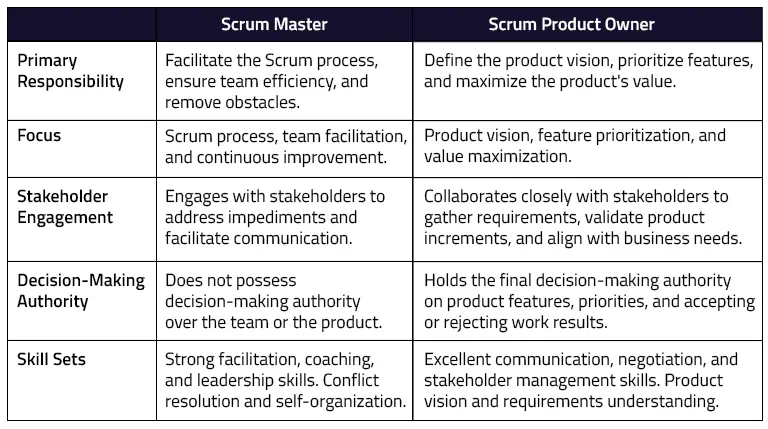The Scrum Master and the Scrum Product Owner are two critical roles within the Agile project management framework that hold the secret to successful project execution. Even though both jobs function according to the Scrum methodology, they have different responsibilities and take on different roles within the Agile ecosystem.
This blog post will review and analyze the key differences between the roles of Scrum Product Owner and Scrum Master, highlighting each role’s distinctive contributions to Agile teams. Organizations may optimize their Agile practices, tap into individual talents, and catapult their projects to success by developing a thorough grasp of these differences.
What’s the Role of a Scrum Master?
The Scrum Master is the Scrum methodology’s facilitator and advocate. Their main role is to guarantee that the team correctly applies and implements the Scrum framework. The Scrum Master is critical in building a collaborative and self-organizing atmosphere among team members. Some important factors to consider are:
-
Facilitating Scrum events:
During daily stand-ups, sprint planning, sprint reviews, and retrospectives, the Scrum Master leads the team. They make sure that these activities are carried out successfully and that the team gets the most out of them. The Scrum Master promotes open dialogue and teamwork among participants throughout these activities.
-
Removing barriers:
Identifying obstacles that might impede the team’s development is one of the Scrum Master’s key duties. Whether the problems are caused by limitations in the team’s resources, external influences, or other causes, they proactively engage with the group to resolve them. The Scrum Master facilitates a smooth workflow by clearing the way for the team.
-
Ensuring compliance with Scrum values:
The Scrum Master serves as the defender of Scrum values and procedures. They inform the team about the fundamental principles of Agile and assist them in successfully adopting Scrum. The team’s self-organization is encouraged, continual development is supported, and a culture of openness and cooperation is established with the aid of the scrum master.
-
Coaching and mentoring:
The Scrum Master helps team members understand and adopt Agile ideals by offering advice and assistance. They guide people in professional development, offer learning opportunities, and coach the team on Agile practices. The Scrum Master takes on the role of a servant-leader, enabling the team to accept responsibility for their work and make wise choices.
What’s the Role of a Scrum Product Owner?
The Scrum Product Owner serves as a connector between the development team and the business side and represents the stakeholders. Maximizing the value of the product and making sure it satisfies end customers’ demands are their main responsibilities. Let’s go over the main responsibilities of the Scrum Product Owner position:
-
Defining product vision and roadmap:
The Product Owner collaborates closely with stakeholders to define the product’s vision and create a plan that is in line with corporate objectives. To define the path of the product, they assemble feedback from a variety of stakeholders, including customers, business analysts, and market research. The product owner successfully and regularly conveys to the team the product vision.
-
Setting priorities and overseeing the product backlog:
The team and the Scrum Product Owner work together to rank user stories and establish acceptance standards. By considering both the demands of the end users and the corporate goals, they make sure that the most useful additions are given first. As input comes in, the Product Owner works with the team to continually improve and modify the backlog.
-
Requirements communication:
A key responsibility of a Scrum Product Owner is effective communication. They collaborate closely with the development team to ensure everyone is aware of the product’s specifications. To ensure efficient development, the product owner simplifies user stories, gives context, and provides clarifications. Additionally, they work together with stakeholders to get input, confirm presumptions, and add appropriate adjustments to the product backlog.
-
Product increment validation:
The Scrum Product Owner is crucial in ensuring that the supplied product increments are legitimate. They assess the development team’s work to make that it satisfies the established acceptance criteria and corresponds to stakeholder expectations. The product owner offers input and works along with the team to progressively enhance the product.
Key Differences Between Scrum Master and Scrum Product Owner
-
Focus:
The key goals of the Scrum Master are to facilitate the Scrum process, ensure team effectiveness, and remove barriers. They want the team to be able to self-organize and produce high-quality work. On the other hand, the Scrum Product Owner is concerned with creating the product vision, ranking features, and maximizing the product’s value. They collaborate closely with stakeholders and the development team to match the product roadmap with corporate goals and end-user requirements.
-
Stakeholder Engagement:
Although both roles communicate with stakeholders, the Scrum Product Owner does so more frequently and directly. They work closely with stakeholders to gather requirements, verify product iterations, and ensure the product is in line with business requirements. The Scrum Master, on the other hand, is more concerned with helping the team and fostering a collaborative atmosphere. Their engagement is not as comprehensive as that of the Product Owner, but they may interact with stakeholders to remove barriers or improve communication.
-
Decision-Making Authority:
When it comes to product functions, priorities, and approving or rejecting work outputs, the Product Owner has the last say. They oversee selecting options that will maximize the worth of the product. However, the Scrum Master has no decision-making power over the team or the final product. Their responsibility is to direct and support the decision-making process, making sure it adheres to Agile principles and is inclusive.
-
Skill Sets:
vTo properly manage the team, the scrum master needs excellent facilitation, coaching, and leadership abilities. They are great at creating self-organization, resolving disputes, and encouraging growth over time. The Scrum Master gives the team the tools they need to take responsibility for their work and come to choices together. The Scrum Product Owner, on the other hand, requires great stakeholder management, negotiating, and communication skills to comprehend and rank user demands while assuring alignment with company objectives. To ensure the success of the product, they serve as the voice of the client, representing the interests of stakeholders and weighing numerous viewpoints.


Conclusion
The Scrum framework has two separate roles: Scrum Master and Scrum Product Owner, both with their responsibilities and contributions. The Scrum Product Owner focuses on creating the product vision, prioritizing features, and maximizing the product’s value whereas the Scrum Master concentrates on facilitating the Scrum process, allowing team efficiency, and removing barriers. Organizations may improve product delivery, create effective collaboration, and maximize their Agile practices by recognizing these variations and utilizing the advantages of each job. Agile teams may develop high-quality products that satisfy the demands of stakeholders and end users by embracing the distinctive contributions of the Scrum Master and the Scrum Product Owner.
Professionals wishing to succeed in Agile project management may gain a great deal from earning a Scrum Master certification. It equips people with in-depth knowledge, useful skills, and a recognized certificate, allowing them to lead teams successfully, encourage collaboration, and drive successful Scrum implementations, eventually improving project results and organizational success.
Become a better Scrum Master with Cognixia
Take advantage of online certified scrum master training if you want to pursue a profession in project management. Scrum Alliance awards the CSM credential to learners who have completed a Certified ScrumMaster course and verified their expertise through the CSM test.
As a Certified Scrum Master, you can perform the following functions:
- Assist your project teams in effectively implementing Scrum
- Contribute knowledge beyond that of a project manager
- Assist your team with cooperation and structure by acting as a ‘servant leader’
- Defend your team against both internal and external distractions
The need for Scrum Masters has grown tremendously as more businesses adopt agile methodologies. Therefore, the CSM certification course is already so popular. As a result, getting a scrum master certification online is highly advised.
Get enrolled in certified scrum master training online with Cognixia – the world’s leading digital talent transformation company.
We are dedicated to assisting learners in shaping their professions and futures in this competitive world by offering them comprehensive digital technology training and certifications. We’re here to provide each aspirant with the finest online learning experience possible. We help them expand their knowledge through interesting training sessions and add value to their resume. Cognixia provides highly engaging instructor-led courses to both individuals and organizations.
Under this online certified Scrum Master training, you will cover the following –
- Agile Thinking
- The Scrum Framework
- Implementation Considerations
- Scrum Roles
- The Scrum Team Explored
- Agile Estimating and Planning
- The Product Owner
- The Scrum Master Explored
Prerequisites for CSM course
Participants must have a basic understanding of software development concepts to take this Scrum Master course from Cognixia. This CSM course is mainly for –
- Members of Scrum teams – developers, Scrum Masters, and product owners
- Managers of Scrum teams
- Teams transitioning to Scrum
- Professionals intending to pursue the Professional ScrumMaster certification

